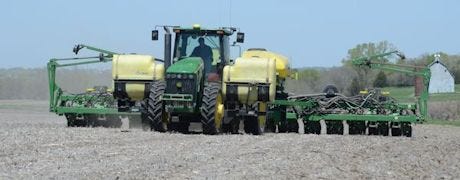
Farmers took advantage of last week's ideal weather to hit the fields in southeast Nebraska. "In the southeast part of the state, we put a lot of seed in the ground last week. We had good moisture conditions for planting, good moisture for germination," says Keith Glewen, University of Nebraska Extension educator in Saunders County.

CORN IN THE GROUND: Robertson Ridge Farms operations manager Dave Bassett planting corn in southwest Lancaster County last week. As Keith Glewen, Nebraska Extension educator in Saunders County notes, "In the southeast part of the state, we put a lot of seed in the ground last week. We had good moisture conditions for planting, good moisture for germination."
Soil temperatures at the end of last week averaged in the low 60's. "It's been creeping up, but we've had cool nights," Glewen says. Night temperatures have dropped down in the low 40's and high 30's. "Even though it gets up into the 70's in the daytime, you don't make big leaps and bounds in soil temperature. When you get nighttime temperatures over 60 degrees Fahrenheit, that's when things really starts rolling."
John McNamara, agronomist at Wiles Brothers, Inc. in Plattsmouth, says, "We're planting into some of the most idyllic conditions I can remember."
After a dry harvest, some timely rains soaked into the soil in August and September, followed by freezing temperatures in early November, and warmer weather and drizzly rain in December, leaving ideal soil moisture conditions this spring. "A corn plant needs to absorb about 20% of its kernel weight in moisture in order to germinate," McNamara says. "We certainly have that."
Wiles Brothers started planting corn on April 6, and finished April 24. Last week, they hit the fields to start planting soybeans. McNamara notes with the ideal conditions last week, it won't take long for farmers get corn in the ground – in some cases, soybeans. "We could probably go from 20% corn planted to well over 50% this week," McNamara said last week. "A lot of these planters can drop a couple hundred acres a day. Some operations have multiple planters, so they can get a lot planted fast."
Technology pushes planting forward
Russel Robertson, owner of Robertson Ridge Farms in southwest Lancaster County, is one such farmer. Last week, he began drilling soybeans while planting corn, which he started planting in mid-April.
~~~PAGE_BREAK_HERE~~~
In southeast Nebraska, rolling hills are prevalent and soil types vary, many of which are highly erodible soils. For several years, Robertson has been using 15-inch rows. "This has been no-till for 20 to 25 years," he says, referring to a field with two-year-old corn residue. "It's classified as highly erodible. With narrow-row corn, I think it's slowing down erosion."
"In my opinion, with narrow rows you get canopy so much sooner, and you don't have near as much weed pressure," adds Robertson Ridge Farms operations manager Dave Bassett. "With tight clay soils, you capture more sunlight, and the moisture stays there longer."
Robertson has also adjusted to this variability in soil and topography with technology like variable-rate seeding. "We've always written prescriptions for populations on corn," Robertson says. Populations on his farm range from 24,000 to 36,000 on dryland, and from 28,000 to 40,000 under irrigation. "I feel real comfortable letting a hired man run a tractor without me having to tell him how to run it. He can see the seeding rate right on the dash board."
This year, Robertson's planter is equipped with a DeltaForce hydraulic active downforce system from Precision Planting, which takes 200 readings a second, or every half inch at five miles per hour to adjust for planting depth based on soil type and topography – some of his fields have as many as 13 different soil types. "It's making adjustments by the computer and hydraulic setup. It would be almost impossible for a human being to do. You can't go out and adjust your planter when you jump from one soil type to the other," Robertson notes. "You get uniformity of seed depth, and more uniform germination," Bassett says.
A constantly changing recipe
Wiles Brothers' soybean test plots will include seed treatments for protection against sudden death syndrome and soybean cyst nematode. The goal is to determine if there is a worthwhile return on investment during an average year compared to a year like last year with greater SDS and SCN pressure.
~~~PAGE_BREAK_HERE~~~
Corn plots include variable rate nitrogen using crop canopy sensors to determine the optimum rate for in-season applications, soil tests to determine areas where phosphorus is deficient, and test plots for starter fertilizers. "This is a recipe that's constantly changing," he adds. "Growing corn or soybeans is kind of like flying an airplane. You make minor changes as you go, but a major change might make you crash."
With the amount of people hitting the fields in the last week, Glewen says, "I'm just amazed at how everything falls together this time of year. You've got fertilizer people, crop protection people, seed people, and farmers all coming together. It's amazing the coordination that goes on across rural America."
"This is one of the great wonders of the world that occurs every year in this country," Glewen adds. "There are a lot of things making the front page right now, but it's truly incredible what's happening right now. We're planting millions and millions of football fields of corn and soybeans."
About the Author(s)
You May Also Like






